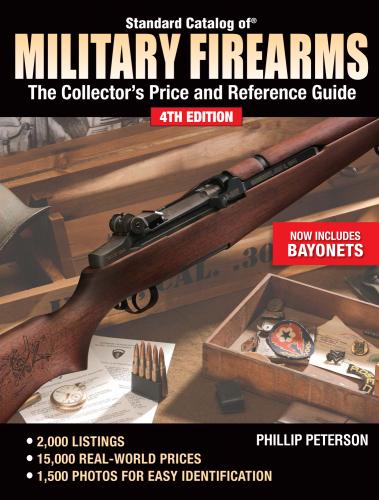Rifles
Machine Guns
SWEDEN
Handguns
Submachine Guns
Rifles
Machine Guns
SWITZERLAND
Handguns
Submachine Guns
Rifles
Machine Guns
TURKEY & OTTOMAN EMPIRE
Handguns
Submachine Guns
Rifles
Machine Guns
UNITED STATES
Handguns
Submachine Guns
Rifles
Shotguns
Machine Guns
YUGOSLAVIA-SERBIA
Handguns
Submachine Guns
Rifles
Machine Guns
CHANGES TO THE 4TH EDITION
Some changes you will find in these pages:
I have changed several entries to better reflect the items that a collector is likely to find here in the United States. An example of this is the Argentine Model 1891 Mauser rifle. Nearly all of these that are encountered in this country had the Argentine crest ground from the receiver. Yet the previous edition made no mention of this at all. So I list the gun with the ground receiver and then add a premium notation for examples with the intact crest. I have treated other models in similar fashion, that is, according to the current mainstream of military firearms collecting in the United States.
A few entries have been moved to the chapter of the nation that actually used an item, rather than the nation where it was made. Firearms made for countries that do not have a separate chapter in this book will remain under the nation that made them.
A new chapter has been added for Egypt. I decided to do this when I found that there were no listings for the Egyptian FN 1949, Hakim and Rasheed rifles or the Helwan pistol.
Also, I have removed pricing for Class III dealer sample firearms. There is no good reason to confuse general readers with pricing on guns that can be owned only by federally-licensed dealers. The dealers will know the going rate for these restricted items.
Now Including Bayonets!
Bayonets are being added to this edition of Standard Catalogue of Military Firearms. Why add bayonets and not other accessory items? Unlike accessories such as slings, cleaning kits, magazines, clips, etc., I think bayonets are an item that many collectors like to acquire to display with the military rifles they own. Some rifles issued with an attached bayonet, such as the SKS, Vz-52 and Mannlicher Carcano Cavalry Carbine were already included in this book, so it just seemed a natural extension to add other bayonets as well.
In my years of dealing in military firearms and bayonets, it has become obvious to me that there are some collectors of military rifles who have no idea what a particular bayonet looks like. They all look alike to an untrained eye. Somebody will point to a Japanese Type 30 bayonet and ask if it fits an M-1 Garand. That is why I decided to include pictures of bayonets. The bayonet entries in this edition will include a picture if I could find an example to show. Blade length and type, handle material, and other identifying features will be included. Manufacturers’ name and other markings on examples shown will be noted. I might mention that this is an ongoing project, and future editions will include even more bayonet listings – and possibly some other accessories as well.
The bayonets and pricing included in SCMF are not intended to be a comprehensive collectors’ guide. There is not enough space available to mention all known variations or makers. Some variations will be worth much more than others to collectors. For detailed reference I suggest the reader consult a bayonet collectors’ work such as Bayonets, From Janzens’ Notebook.
My sincere thanks to the following individuals who allowed me to photograph bayonets in their possession:
Mark Augsberger
Larry Brown
Paul Bunin
Mike Cook
Nyle Johnson
Ben Payer
Jerry Pierfederici
James Romig
The reader may find the following schematic helpful in understanding the bayonet listings included in this book:
I hope the above changes have resulted in a more accurate, more interesting, and easier-to-use book.
BASIC BAYONET NOMENCLATURE
ACKNOWLEDGMENTS
Orval Reichert is a collector of WWII-era semi-automatic pistols, especially the P38, and has been an invaluable help in sorting out a sometimes confusing array of pistol variations. He can be reached at P.O. Box 67, Vadar, WA, 98593.
Joe Gaddini, of SWR, has provided invaluable technical assistance on Class III firearms and suppressors. He can be reached at 119 Davis Road, Suite G-12, Martinez, GA, 30907.
Thanks to Eric M. Larsen for his information concerning Federal firearms laws.
Special thanks go to Simeon Stoddard, former curator of the Cody Firearms Museum, for his research into and contributions concerning the M1 Garand rifle.
Nick Tilotta is an expert on Thompson submachine guns. He helped to explain the subtle differences between models and can be reached at P.O. Box 451, Grapevine, TX, 76099.
Don Westmoreland is a serious student of Japanese and German WWII automatic weapons. His knowledge was extremely valuable.
Gunsmith Stan Andrewski can be reached at 603-746-4387 and is recommended to anyone needing firtst-class work on Class III weapons.
Dan Shea, editor and publisher of Small Arms Review, lent his mastery of Class III firearms.
Ted Dawidowicz of Dalvar USA lent numerous photos of imported Polish military firearms. He may be reached at 702-558-6707.
Jim Alley (937-773-4203) of IDSA Books was most generous in granting use of his extensive personal library.
Blake Stevens (905-342-3434) of Collector Grade Publications shared his vast knowledge as well as select photographs from his personal collection.
The suggestions of Ricky Kumor, Sr., and J. B. Wood contributed much to earlier editions of this book – and to this one as well.
The assistance of small arms expert James Rankin is gratefully acknowledged.
Mark Keefe, editor of American Rifleman, contributed valuable information on Lee-Enfield rifles.
Richard Wray and Ken Keilholz shared their encyclopedic knowledge and photographs of Class III firearms, without which this would be a lesser book.
J. R. Moody was generous in his assistance concerning Class III and sniper weapons.
Thanks go out to Pedro Bello for sharing his extensive knowledge of machine pistols.
Charlie Cutshaw provided valuable information on rare and hard-to-find military weapons.
